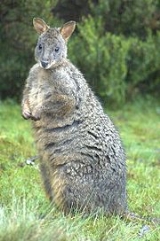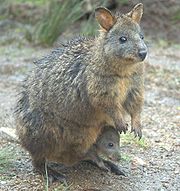
Tasmanian Pademelon
Encyclopedia
The Tasmanian Pademelon (Thylogale billardierii), also known as the Rufous-bellied Pademelon or Red-bellied Pademelon, is the sole endemic species of pademelon
found in Tasmania
, and formerly throughout south-eastern Australia. This pademelon has developed a more full and bushy fur than its northern relatives, who inhabit northern Australia
and Papua New Guinea
.
Males reach around 12 kg (26.5 lbs) in weight, 1 - 1.2 metres in height, and are considerably larger than the females, who average 3.9 kg (8.6 lbs).
, sclerophyll
forest
, and scrubland are preferred, although wet gullies in dry open eucalypt
forest are also used. Such places, next to open areas where feeding can occur, are especially favoured. After dusk, the animals move onto open areas to feed, but rarely stray more than 100 metres from the forest edge.
The species is abundant and widespread throughout Tasmania.
feeding on a wide variety of plants, from herbs, green shoots and grass, to some nectar-bearing flowers.
Once a part of the diet of the Thylacine
, the Tasmanian Pademelon is still preyed upon by other predators of the island, including the Tasmanian Devil
and quoll
s. Even so, they are abundant to the point of being culled
occasionally (along with other wallabies
) to reduce competition for grass with the farmed animals. Hunting of the Tasmanian Pademelon is allowed, its pelt having some economic value and its meat being palatable.
 There is no specific breeding season, though 70% of pademelon births seem to occur around the beginning of winter. Gestation
There is no specific breeding season, though 70% of pademelon births seem to occur around the beginning of winter. Gestation
for the female is 30 days. The young are in the pouch for about 6 months thereafter, and are weaned at around 8 months. Joeys are sexually mature at 14 - 15 months. Pademelons live between 5 to 6 years in the wild.
Pademelon
Pademelons are small marsupials of the genus Thylogale. They are usually found in forests. Pademelons are the smallest of the macropods...
found in Tasmania
Tasmania
Tasmania is an Australian island and state. It is south of the continent, separated by Bass Strait. The state includes the island of Tasmania—the 26th largest island in the world—and the surrounding islands. The state has a population of 507,626 , of whom almost half reside in the greater Hobart...
, and formerly throughout south-eastern Australia. This pademelon has developed a more full and bushy fur than its northern relatives, who inhabit northern Australia
Australia
Australia , officially the Commonwealth of Australia, is a country in the Southern Hemisphere comprising the mainland of the Australian continent, the island of Tasmania, and numerous smaller islands in the Indian and Pacific Oceans. It is the world's sixth-largest country by total area...
and Papua New Guinea
Papua New Guinea
Papua New Guinea , officially the Independent State of Papua New Guinea, is a country in Oceania, occupying the eastern half of the island of New Guinea and numerous offshore islands...
.
Males reach around 12 kg (26.5 lbs) in weight, 1 - 1.2 metres in height, and are considerably larger than the females, who average 3.9 kg (8.6 lbs).
Habitat
Pademelons are solitary and nocturnal, spending the daylight hours in thick vegetation. RainforestRainforest
Rainforests are forests characterized by high rainfall, with definitions based on a minimum normal annual rainfall of 1750-2000 mm...
, sclerophyll
Sclerophyll
Sclerophyll is the term for a type of vegetation that has hard leaves and short internodes . The word comes from the Greek sclero and phyllon ....
forest
Forest
A forest, also referred to as a wood or the woods, is an area with a high density of trees. As with cities, depending where you are in the world, what is considered a forest may vary significantly in size and have various classification according to how and what of the forest is composed...
, and scrubland are preferred, although wet gullies in dry open eucalypt
Eucalyptus
Eucalyptus is a diverse genus of flowering trees in the myrtle family, Myrtaceae. Members of the genus dominate the tree flora of Australia...
forest are also used. Such places, next to open areas where feeding can occur, are especially favoured. After dusk, the animals move onto open areas to feed, but rarely stray more than 100 metres from the forest edge.
The species is abundant and widespread throughout Tasmania.
Diet
The Tasmanian Pademelon is a nocturnal herbivoreHerbivore
Herbivores are organisms that are anatomically and physiologically adapted to eat plant-based foods. Herbivory is a form of consumption in which an organism principally eats autotrophs such as plants, algae and photosynthesizing bacteria. More generally, organisms that feed on autotrophs in...
feeding on a wide variety of plants, from herbs, green shoots and grass, to some nectar-bearing flowers.
Once a part of the diet of the Thylacine
Thylacine
The thylacine or ,also ;binomial name: Thylacinus cynocephalus, Greek for "dog-headed pouched one") was the largest known carnivorous marsupial of modern times. It is commonly known as the Tasmanian tiger or the Tasmanian wolf...
, the Tasmanian Pademelon is still preyed upon by other predators of the island, including the Tasmanian Devil
Tasmanian Devil
The Tasmanian devil is a carnivorous marsupial of the family Dasyuridae, now found in the wild only on the Australian island state of Tasmania. The size of a small dog, it became the largest carnivorous marsupial in the world following the extinction of the thylacine in 1936...
and quoll
Quoll
The quoll, or native cat, is a carnivorous marsupial native to mainland Australia, New Guinea and Tasmania. It is primarily nocturnal and spends most of the day in its den. There are six species of quoll; four are found in Australia and two in New Guinea...
s. Even so, they are abundant to the point of being culled
Culling
Culling is the process of removing animals from a group based on specific criteria. This is done either to reinforce certain desirable characteristics or to remove certain undesirable characteristics from the group...
occasionally (along with other wallabies
Wallaby
A wallaby is any of about thirty species of macropod . It is an informal designation generally used for any macropod that is smaller than a kangaroo or wallaroo that has not been given some other name.-Overview:...
) to reduce competition for grass with the farmed animals. Hunting of the Tasmanian Pademelon is allowed, its pelt having some economic value and its meat being palatable.
Breeding

Gestation
Gestation is the carrying of an embryo or fetus inside a female viviparous animal. Mammals during pregnancy can have one or more gestations at the same time ....
for the female is 30 days. The young are in the pouch for about 6 months thereafter, and are weaned at around 8 months. Joeys are sexually mature at 14 - 15 months. Pademelons live between 5 to 6 years in the wild.

